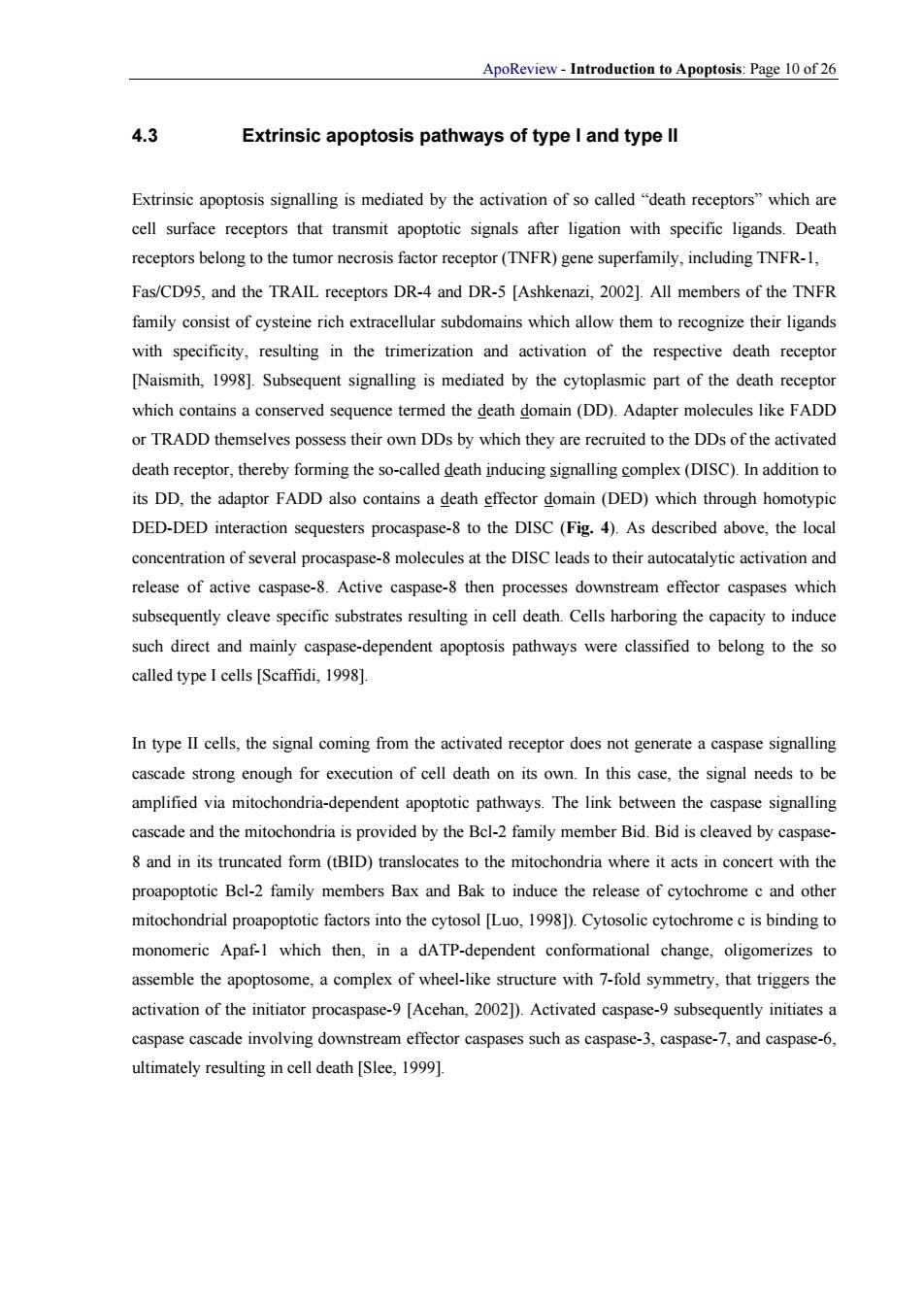正在加载图片...

ApoReview-Introduction to Apoptosis:Page 10of 26 4.3 Extrinsic apoptosis pathways of type I and type ll Extrinsic apoptosis signalling is mediated by the activation of so called"death receptors"which are cell surface receptors that transmit apoptotic signals after ligation with specific ligands.Death receptors belong to the tumor necrosis factor receptor(TNFR)gene superfamily,including TNFR-1, Fas/CD95,and the TRAIL receptors DR-4 and DR-5 [Ashkenazi,2002].All members of the TNFR family consist of cysteine rich extracellular subdomains which allow them to recognize their ligands with specificity,resulting in the trimerization and activation of the respective death receptor [Naismith,1998].Subsequent signalling is mediated by the cytoplasmic part of the death receptor which contains a conserved sequence termed the death domain (DD).Adapter molecules like FADD or TRADD themselves possess their own DDs by which they are recruited to the DDs of the activated death receptor,thereby forming the so-called death inducing signalling complex(DISC).In addition to its DD.the adaptor FADD also contains a death effector domain(DED)which through homotypic DED-DED interaction sequesters procaspase-8 to the DISC(Fig.).As described above.the loca concentration of several procaspase-8 molecules at the DISC leads to their autocatalytic activation and release of active caspase-8.Active caspase-8 then processes downstream effector caspases which subsequently lave specific substrates resulting incell death.Cells harboring the capacity to induce such direct and mainly caspase-dependent apoptosis pathways were classified to belong to the so called type I cells[Scaffidi,199] In type II cells.the signal coming from the activated receptor does not generate a caspase signalling cascade strong enough for execution of cell death on its own.In this case,the signal needs to be amplified via mitochondria-dependent apoptotic pathways.The link between the caspase signalling cascade and the mitochondria is provided by the Bcl-2 family member Bid.Bid is cleaved by caspase 8 and in its truncated form(tBID)translocates to the mitochondria where it acts in concert with the proapoptotic Bel-2 family members Bax and Bak to induce the release of cytochrome c and other mitochondrial proapoptotic factors into the cytosol [Luo,1998]).Cytosolic cytochrome c is binding to monomeric Apaf-1 which then,in a dATP-dependent conformational change.oligomerizes to assemble the apoptosome,a complex of wheel-like structure with 7-fold symmetry,that triggers the activation of the initiator procaspase-9 [Acehan,20021).Activated caspase-9 subsequently initiates a caspase cascade involving downstream effector caspases such as caspase-3.caspase-7,and caspase-6. ultimately resulting in cell death [Slee,19991. ApoReview - Introduction to Apoptosis: Page 10 of 26 4.3 Extrinsic apoptosis pathways of type I and type II Extrinsic apoptosis signalling is mediated by the activation of so called “death receptors” which are cell surface receptors that transmit apoptotic signals after ligation with specific ligands. Death receptors belong to the tumor necrosis factor receptor (TNFR) gene superfamily, including TNFR-1, Fas/CD95, and the TRAIL receptors DR-4 and DR-5 [Ashkenazi, 2002]. All members of the TNFR family consist of cysteine rich extracellular subdomains which allow them to recognize their ligands with specificity, resulting in the trimerization and activation of the respective death receptor [Naismith, 1998]. Subsequent signalling is mediated by the cytoplasmic part of the death receptor which contains a conserved sequence termed the death domain (DD). Adapter molecules like FADD or TRADD themselves possess their own DDs by which they are recruited to the DDs of the activated death receptor, thereby forming the so-called death inducing signalling complex (DISC). In addition to its DD, the adaptor FADD also contains a death effector domain (DED) which through homotypic DED-DED interaction sequesters procaspase-8 to the DISC (Fig. 4). As described above, the local concentration of several procaspase-8 molecules at the DISC leads to their autocatalytic activation and release of active caspase-8. Active caspase-8 then processes downstream effector caspases which subsequently cleave specific substrates resulting in cell death. Cells harboring the capacity to induce such direct and mainly caspase-dependent apoptosis pathways were classified to belong to the so called type I cells [Scaffidi, 1998]. In type II cells, the signal coming from the activated receptor does not generate a caspase signalling cascade strong enough for execution of cell death on its own. In this case, the signal needs to be amplified via mitochondria-dependent apoptotic pathways. The link between the caspase signalling cascade and the mitochondria is provided by the Bcl-2 family member Bid. Bid is cleaved by caspase- 8 and in its truncated form (tBID) translocates to the mitochondria where it acts in concert with the proapoptotic Bcl-2 family members Bax and Bak to induce the release of cytochrome c and other mitochondrial proapoptotic factors into the cytosol [Luo, 1998]). Cytosolic cytochrome c is binding to monomeric Apaf-1 which then, in a dATP-dependent conformational change, oligomerizes to assemble the apoptosome, a complex of wheel-like structure with 7-fold symmetry, that triggers the activation of the initiator procaspase-9 [Acehan, 2002]). Activated caspase-9 subsequently initiates a caspase cascade involving downstream effector caspases such as caspase-3, caspase-7, and caspase-6, ultimately resulting in cell death [Slee, 1999]